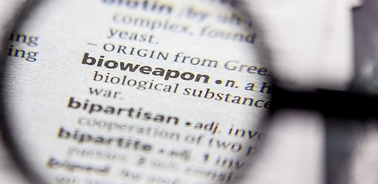- Home
- The Specter Of A Bioweapon
The Specter of a Bioweapon

The latest strain of the coronavirus, has not only created a modern-day pandemic but it has reenergized a flurry of accusations that it's a man-made bioweapon.
By Dr. Oscar Jonsson, Academic Director, Center for the Governance of Change, IE.
The latest round of theories has focused on the Wuhan Institute of Virology as the originator of the virus. The Chinese institute had, in 2015, been part of the reverse-engineering of an earlier SARS-CoV strain that the Chinese Foreign Ministry-Spokesperson, Zhao Lijian, had in fact accused the US military of bringing to Wuhan.
Even though new research in Nature Medicine by Andersen et al. comparing the genomes of the SARS-CoV-2 has since shown that the Coronavirus is not a purposefully manipulated virus or constructed in a lab, the notion that Corona could be manmade is still lingering and the United States continues to press Chinese officials to enter and investigate the labs in Wuhan.
Back in 2016, the US Bipartisan Commission on Biodefense warned that the “nation remains woefully underprepared for dangerous biological incidents.” Events have proven them correct. More than two and a half million people have been infected by SARS-CoV-2 around the world, almost two hundred thousand have died, and an economic havoc threatens our well-being for the coming decade. The specter of bioweapons is here to stay, particularly since the SARS-CoV-2 is the result of only a slight mutation from an already known family of virus, yet its impact was immense.
Progress in synthetic biology – the manipulation of DNA through bioengineering - holds tremendous promise in bringing forth a sixth industrial revolution with the potential to remake healthcare, nutrition, materials, energy production, and even ourselves. The field is advancing with drastically lowered costs for production and sequencing DNA, as well as readily accessible information online. This has, among other things, led to an upsurge in “biohacking,” or DIY synthetic biology-labs.
As with all technologies that become more effective and accessible, the potential risk associated with synthetic biology also increases. The use of bioweapons is almost as old as warfare itself; in the Exodus, Yahweh inflicted ten plagues upon the Egyptian population. At the beginning of this century, scientist successfully reconstructed, with the use of synthetic biology, the Spanish Flu, a virus responsible for between 20 to 50 million deaths. In 2014, a computer captured from ISIS included a manual for creating a biological weapon based on the Bubonic plague, complete with instructions on how to maximize effect via confined and crowded places. Whilst large-scale bioattacks have yet to been successful, both their likelihood and potential impact will increase.
A common counter-argument to concerns regarding the use of such bioweapons is that whilst information and DIY-labs are accessible, producing a coherent virus requires experience and tacit knowledge, much like how the blueprints of an airplane are readily available but hardly reproducible. However, these arguments fall short because the fast maturation of technology precisely enables the transformation of tacit knowledge into explicit knowledge. Consider also how the 9/11 hijackers devoted the required time to build the experience needed to fly airplanes and turn them into a weapon against civilians.
Whilst the prime threat from bioweapons is still posed by states with both large-scale facilities and know-how, that threat is mitigated by the fact that such attacks could be attributed. As is with cyber weapons, states that are not under existential threat will use the weapons cautiously for fear of retribution.
Terrorist groups, on the other hand, especially those with a doomsday flavor, are undeterred by potential retribution, in fact they are often motivated by it. The use of biological weapons is nominally banned under the Biological Weapons Convention, but the ban lacks compliance and inspections mechanisms - and furthermore research for biodefence is allowed (and the line between offence and defense is blurry.)
The Coronavirus pandemic underlines just how vulnerable our societies are to a fast spreading virus. The silver lining might be, however, that because of this pandemic, our ability to cope with a bioterrorist attack has increased. That is not sufficient though, and increased effort must be put toward licensing, monitoring, and building biodefenses in order to ensure that we can enjoy the progress and prosperity that will come from advances in synthetic biology.